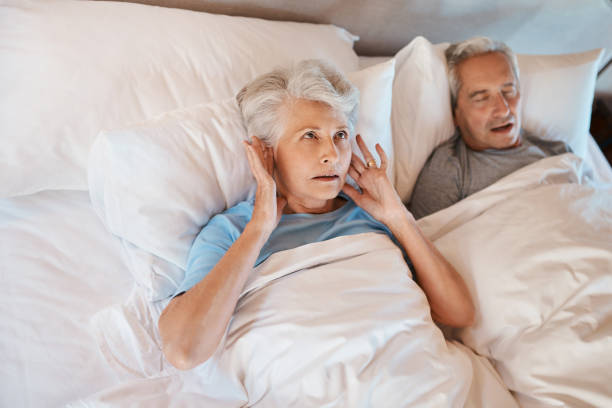Introduction

Parkinson's disease, a progressive neurological disorder, poses significant challenges regarding early detection. However, recent scientific investigations have revealed a fascinating connection between breathing patterns during sleep and the prediction of Parkinson's disease. Sleep is a crucial time for the body's rejuvenation, and it turns out that analyzing changes in respiratory patterns during this period can offer valuable insights into the presence of Parkinson's disease.
In this blog post, we will explore the emerging field of research that examines how alterations in breathing patterns during sleep can serve as potential indicators for Parkinson's disease, opening up new possibilities for early diagnosis and intervention strategies.
What is Sleep-Disordered Breathing?

Sleep-disordered breathing (SDB) is a condition that occurs when there are disruptions to the typical breathing patterns during sleep, primarily caused by alterations in airway resistance. This condition encompasses various symptoms, including shallow breathing, temporary cessations in breathing, or heightened exertion and difficulty in breathing due to obstructions in the air passages. Individuals affected by SDB are more susceptible to additional health complications, including elevated blood pressure, stroke, and depression.
Night breathing patterns identify people with Parkinson's disease.
Recent studies have revealed that breathing patterns during sleep can be used to predict Parkinson's disease. Changes in how people breathe at night, such as an increase in the inspiratory duration or a decrease in morning deep breaths, can indicate the presence of the neurological disorder before it is clinically diagnosed.
Scientists have been aware for a considerable period that individuals diagnosed with Parkinson's disease commonly experience disruptions in their sleep patterns. What has been more difficult to measure is the severity of these disturbances and how they correlate with clinical symptoms in the progression of the disease. This is why studying breathing patterns during sleep has become important in helping scientists better understand how Parkinson's disease may develop.
Researchers from the University of Tokyo have found individuals with Parkinson's disease to have shorter inhalations and fewer deep breaths in the morning compared to those who do not have Parkinson's, according to a recent study. The researchers utilized machine learning algorithms and achieved a success rate of 83.3% in identifying one group from the other. They also had a specificity score of 76.6%.
These findings suggest that changes in sleep breathing patterns could be an early indication of Parkinson's disease, occurring before its clinical diagnosis. The discovery could help healthcare professionals detect Parkinson's disease earlier, leading to interventions that slow the disease's progression.
The study also reveals that sleep apnea may occur more frequently in people with Parkinson's, as the decrease in inspiratory duration and number of morning deep breaths suggest underlying airway obstructive issues. As such, doctors must pay close attention to breathing patterns during sleep when diagnosing or managing Parkinson's disease.
In addition to providing insight into the progression of Parkinson's, further research is needed to determine how changes in sleep-breathing patterns can be used to prevent and treat the disorder. For instance, if researchers were able to accurately predict the likelihood of developing Parkinson's by analyzing sleep breathing patterns, then interventions could be carried out to mitigate the risk.
What is the connection between breathing patterns during sleep and Parkinson's Disease?

The connection between breathing patterns during sleep and Parkinson's Disease is well established. Changes in breathing patterns during sleep are now being used to predict an individual's risk of developing the condition.
The most common symptom observed in those with Parkinson's Disease is impaired movement due to dopamine deficiency in the brain. However, these symptoms can be difficult to detect in the early stages. As a result, recognizing changes in breathing patterns during sleep can effectively identify the disease, allowing for earlier intervention and treatment.
Here is a list of how changes in breathing patterns during sleep can predict Parkinson's Disease:
Excessive snoring
Excessive snoring has been linked to higher levels of dopamine deficiency in the brain, which can lead to Parkinson's Disease.
Obstructive Sleep Apnea
OSA is a disorder in which an individual stops breathing briefly while sleeping. Studies have shown that those with OSA are more likely to develop Parkinson's Disease than those who do not suffer from OSA.
Increased breathing rate and pauses
Individuals with Parkinson's Disease often exhibit an increased breathing rate during sleep and increased pauses between breaths.
Hypopnea Syndrome
Hypopnea Syndrome is characterized by shallow or reduced breathing during sleep. Those with HS are at greater risk for developing Parkinson's Disease.
Abnormal oxygen levels
Researchers have noticed that people who have Parkinson's Disease experience unusual oxygen levels while they are sleeping. This may also worsen the progression of the disease.
What are the symptoms of Parkinson's Disease?
Here are some symptoms of Parkinson's Disease that you should be aware of:
Tremors:
One of the most common signs of Parkinson's Disease (PD) is tremors. The cause of this is an imbalance in the brain and nervous system regions responsible for controlling movement. Tremors usually start as small, slight hand or arm movements. Over time, they can become more intense and affect other body parts like the legs, chin, and face. It's also possible to experience tremors even when resting or sleeping.
The type of tremor seen in Parkinson's Disease is called a rest tremor because it occurs when the body is at rest. The movement can sometimes be so severe that it interferes with everyday activities like eating and writing. With PD, tremors usually start on one side of the body but can eventually affect both sides as the disease progresses.
Rigidity or Stiffness:
Rigidity or stiffness in muscles is another common symptom of Parkinson's Disease. This occurs when the muscles become tight and unable to move normally. Muscle rigidity can affect any body part but usually begins in the arms, legs, or neck. People with PD may experience a feeling of being "frozen" in place, with the inability to move their body parts freely.
Muscle rigidity or stiffness can impact a person's ability to move and complete basic tasks such as getting dressed, walking up stairs, or turning the head. This condition is also associated with alterations in breathing patterns while sleeping, which can indicate Parkinson's disease. As the disease worsens, it might get challenging to move in a coordinated manner because of rigidity. This could affect your balance and walking ability, increasing your chances of falling.
Slowed Movement:
Slowed movement, or bradykinesia, is another symptom of Parkinson's Disease. Parkinson's disease can cause slow muscle movements, making it hard to start moving. People with PD may struggle with tasks that require precise movements, like buttoning a shirt or writing with a pen. It can also affect walking and balance, making posture unsteady.
Slowed movement can also cause changes in breathing patterns during sleep, linked to an increased risk of Parkinson's Disease. For instance, people with PD may experience shallow or rapid breaths while sleeping due to the slowing down their respiratory muscles. They may also have difficulty controlling their breathing rate during sleep, which can lead to long pauses in breathing or irregular breathing patterns.
Changes in respiratory function during sleep are important predictors of Parkinson's Disease and should be monitored closely. Early diagnosis and treatment of PD can improve your life quality and lower the risk of developing serious complications.
How does Parkinson's Disease impact the respiratory control centers in the brain?
Parkinson's Disease (PD) is a condition that affects the neurotransmitters in the brain, leading to various issues in different areas of the body. Specifically, it can affect the respiratory control centers found in the brainstem.
Research has shown that patients with PD typically display anatomical changes in their central respiratory control centers, including the medulla's ventral and dorsal motor nuclei. These changes can lead to alterations in breathing patterns during sleep and disturbed ventilation during wakefulness.
Additionally, patients with PD may have deficits in respiratory mechanics, such as decreased tidal volume and increased inspiratory time.
The impact of PD on the respiratory control centers may also be related to changes in the basal ganglia. The basal ganglia are responsible for modulating movement, but they can also affect breathing due to their influence over the medulla's ventral and dorsal motor nuclei. In PD, there is an imbalance in activity within the basal ganglia, which can interfere with normal breathing patterns.
Furthermore, PD patients may display changes in respiratory control due to alterations in their autonomic nervous system (ANS). The ANS is responsible for controlling unconscious physiological processes such as breathing, and research suggests that PD patients may experience a disruption in their ANS, which leads to reduced respiratory drive.
Finally, Parkinson's Disease can significantly impact the central respiratory control centers in the brainstem. These changes can lead to disturbances in breathing patterns during wakefulness and sleep and deficits in respiratory mechanics. Furthermore, changes in the basal ganglia and autonomic nervous system may contribute to alterations in respiratory control. Clinicians must understand how PD can affect the respiratory system to provide appropriate treatment and assistance to their patients.
FAQ's
Is there a link between sleep apnea and Parkinson's?
Yes, there is a link between sleep apnea and Parkinson's Disease. Research indicates that individuals with PD may have difficulty breathing during sleep because their respiratory muscles weaken. This could result in shallow breathing or rapid breathing. People with PD also have difficulty controlling their breathing rate during sleep which can lead to long pauses in breathing or irregular breathing patterns, both of which are sleep apnea symptoms.
What sleep disorders are associated with Parkinson's disease?
The most common sleep disorder associated with Parkinson's is REM Sleep Behavior Disorder (RBD). People with RBD have difficulty controlling their reflexive muscle movements during rapid eye movement (REM) sleep, leading to complex and potentially dangerous behaviors such as punching, kicking, or jumping out of bed. People with Parkinson's may also suffer from sleep apnea, periodic limb movement disorder, and insomnia.
What is the most common initial manifestation of Parkinson's disease?
The most common initial manifestation of Parkinson's disease is tremor. A tremor is when a part of the body shakes uncontrollably, often beginning on one side and then spreading to both sides. Other early symptoms may include slow movement, limb stiffness, impaired balance and coordination, and decreased facial expression.
What are the four most common clinical manifestations seen in Parkinson's disease?
The four most common clinical manifestations of Parkinson's disease are tremors, bradykinesia, rigidity, and postural instability. A tremor is an uncontrollable shaking of the limbs or body parts. Bradykinesia refers to slowing movements, while rigidity describes increased muscle tone and stiffness. Postural instability describes a loss of balance when standing or walking.
How can you detect Parkinson's disease early?
Early detection of Parkinson's disease is important to ensure the best possible patient outcomes. Some early signs and symptoms of PD include tremors, bradykinesia, rigidity, postural instability, and changes in mood or behavior, such as depression or anxiety.
Conclusion
I hope this article has clarified how altered breathing during sleep can indicate Parkinson's Disease. Detecting PD early is crucial for providing timely treatment and support. Therefore, healthcare providers must be alert to potential symptoms. Increased knowledge of how breathing changes can signal PD can aid in ensuring patients receive proper care at the right time.

